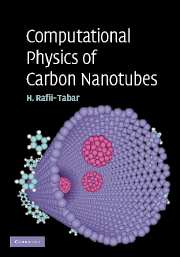10 - Modelling the mechanical properties of carbon nanotubes
Published online by Cambridge University Press: 29 September 2009
Summary
Computational investigation of the mechanical properties of carbon nanotubes is one of the most active research fields in the physics of nanotubes due to the importance of these properties in the practical applications of nanotubes in nanotechnology devices. Experimental and theoretical/computational modelling studies indicate that SWCNTs and MWCNTs enjoy extraordinary mechanical properties. The computational modelling in this field has employed some of the highly sophisticated atomistic and continuum-elasticity models, showing that, for instance, carbon nanotubes have high tensile strengths, large bending flexibilities and high aspect ratios. These are properties that make nanotubes an ideal material for superstrong nanofibres. Defect-free nanotubes have no exposed edges in the direction parallel to the axis of the nanotube, in contrast to graphene sheets, and as a result they can resist fracture or crack-formation in the direction perpendicular to the externally applied strain.
A rather extensive part of the research concentrates on the computation of the elastic constants, Poisson's ratios and Young's moduli of SWCNTs, MWCNTs and their respective bundles (ropes), aiming to show the dependence of these properties on the diameter and chirality of the nanotubes. A very interesting aspect of the computational modelling of the mechanical properties of nanotubes that has clearly emerged from the research in this area of nanotube physics is the relevance of the well-established continuum-based theories of curved plates, thin shells, beams and vibrating rods, to model and interpret the response of nanotubes to external influences, such as large strains, or the flow of fluids inside nanotubes.
- Type
- Chapter
- Information
- Computational Physics of Carbon Nanotubes , pp. 277 - 449Publisher: Cambridge University PressPrint publication year: 2007



